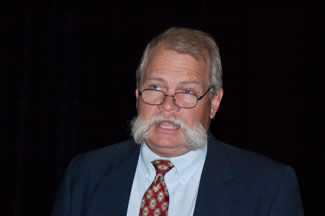Strategic Use of Heterosis
Targeted heterosis remains an effective means of increasing pounds of calf weaned per cow exposed.
by Troy Smith, Angus Media filed editorPlenty has been written about heterosis. Volumes of information exist related to heterosis — the hybrid vigor, or enhanced performance, exhibited by crossbred animals when compared to the average of their purebred parents. Todd Thrift wonders why relatively few commercial cow-calf producers take advantage of the available knowledge. Why aren’t more producers reaping the advantages of heterosis?

University of Florida animal scientist, Todd Thrift.
An animal scientist at the University of Florida, Thrift posed that question to cattle enthusiasts attending the 2017 Beef Improvement Federation (BIF) Research Symposium and Convention hosted May 31-June 3 in Athens, Ga. He challenged the decades-old disdain for crossbreeding, a tool proven useful for increasing cow-calf profitability.
Well, not everyone has ignored the advantages of heterosis. While many cattlemen across much of the United States have indulged a preference for straightbred cow herds, many Gulf Coast producers have benefited from crossbred herds utilizing Brahman influence.
“Many consider the F-1 Brahman-cross to be the ‘Cadillac Cow’ for that environment,” said Thrift, noting how the infusion of Brahman genetics increases adaptability to subtropical conditions. “As the production environment worsens, the more heterosis can matter. The Gulf Coast is a good example.”
Just as valid, said Thrift, are crossbreeding systems involving complementary breeds that are suited to other production environments. While some people have suggested that individual breed improvement has advanced to the point crossbreeding is no longer advantageous, Thrift insisted that targeted heterosis remains a highly effective means of increasing pounds of calf weaned per cow exposed.
“Hybrid vigor is highest for maternal traits, so the biggest bang for the crossbreeding buck comes from using a crossbred cow,” added Thrift, noting how profitability can be improved through increases in cow fertility, calf survival and cow longevity.
Thrift said successful crossbreeding requires a planned, targeted approach. He admitted, however, that such breeding systems are not necessarily easy to apply. Heterosis can be achieved, at various levels, utilizing crossbreeding systems of three types: terminal, rotational and composite.
Generally, terminal-sire systems deliver maximum heterosis and enable a producer to focus on the end product. Terminal crossbreeding systems are not meant to produce replacement heifers. Instead, replacement females are purchased. However, the plan may fall apart when a producer succumbs to temptation and keeps some “big, good-looking replacement heifers” from a terminal mating.
Rotational systems provide a lower level of hybrid vigor, but produce replacement females. Thrift said an increased number of breeding pastures may be required to maintain the breeding rotation, which may be challenging to smaller operations. Large operations also may be better suited to rotational systems because they may have the ability to market different types and colors of offspring.
Composite systems also offer heterosis, the most coming from composites developed from four breeds (25% each). According to Thrift, utilization of cattle representing an already established composite may be well-suited to small operations, because breeding can be managed similarly to a straightbred system.
Thrift said it is unfortunate, but many producers do not stick with a crossbreeding system long enough to realize the benefits. Too often the lure of some new breed or cross will divert attention from the original plan.
“Producers have to realize that successful crossbreeding requires a long-term commitment,” advised Thrift. “If they want to know how to make strategic use of heterosis, my answer would be to use a crossbred cow.”
Editor’s Note: This summary was written under contract or by staff of Angus Media. Through an agreement with the Beef Improvement Federation,
we are encouraging reprinting of the articles to those who will adhere
to the reprint guidelines available on this site. Please review those
guidelines or contact Shauna Rose Hermel,
editor, at 816-383-5270. PowerPoints are posted with permission of the
presenter and may not be reproduced in whole or in part without the
express permission of the presenter.
Angus Media’s coverage of the event is made possible through
collaboration with BIF. For questions about this site, or to notify us
of broken links, click here. Look for additional coverage in the Angus Journal, the Angus Beef Bulletin, the Angus Journal Daily, the Angus Beef Bulletin EXTRA and Angus TV.


